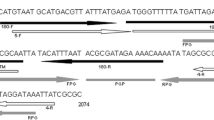Abstract
An alternative approach for optimisation of multiple polymerase chain reaction (PCR) by means of experimental design techniques is described. In initial experiments, the effects of independent variables: deoxyribonucleotides (dNTPs), Mg2+ and primers on multiple PCR were determined by Full Factorial Design. According to the results, each factor (stand-alone or composed ones) influences the amplification of individual genes in multiple PCR in a different way. A three-dimensional Simplex optimisation strategy was used for studying and consequently for improving multiple PCR yields. Using optimised concentrations of dNTPs, Mg2+ and primers in PCR, an improved simultaneous amplification of pkaC and pepC was achieved. Moreover, also in duplex RT-PCR the optimised PCR significantly increased the yield of both transcripts. The outlined optimisation strategy could be adopted to any multiple PCR or RT–PCR.
Similar content being viewed by others
References
Ben?ina M, Legiša M (1999) Non-radioactive multiple reverse transcription-PCR method used for low abundance mRNA quantification. Biotechnol. Tech. 13: 865-869.
Ben?ina M, Legiša M (2000) Stress mediated changes in expression of the pkaC gene, encoding the catalytic subunit of cAMPdependent protein kinase, in Aspergillus niger. Pflügers Arch. Eur. J. Physiol. 439: R76-R78.
Ben?ina M, Panneman H, Ruijter GJG, Legiša M, Visser J (1997) Characterisation and overexpression of the Aspergillus niger gene encoding the cAMP-dependent protein kinase catalytic subunit. Microbiology 143: 1211-1220.
Boleda MD, Briones P, Farres J, Tyfield L, Pi R (1996) Experimental design: a useful tool for PCR optimisation. BioTechniques 21: 134-140.
Burton KWC, Nickless G (1987) Optimisation via Simplex. Part I. Background, definitions and a simple application. Chemometr. Intell. Lab. Syst. 1: 135-149.
Chamberlain JS, Chamberlain JR (1994) Optimisation of multiplex PCRs. In: Mullis KB, Ferre F, Gibbs RA, eds. The Polymerase Chain Reaction. Boston: Birkhauser, pp. 38-46.
Cobb BD, Clarkson M (1994) A simple procedure for optimizing the polymerase chain reaction (PCR) using modified Taguchi methods. Nucl. Acid Res. 22: 3801-3805.
de Graaff L, van de Broeck HC, Visser J (1988) Isolation and expression of the Aspergillus nidulans pyruvate kinase gene. Curr. Genet. 13: 315-321.
Ferre F, Marchese A, Pezzoli P, Griffin S, Buxton E, Boyer V (1994) Quantitative PCR: an overview. In: Mullis KB, Ferre F, Gibbs RA, eds. The Polymerase Chain Reaction. Boston: Birkhauser, pp. 67-88.
Frederick GD, Rombouts P, Buxton FP (1993) Cloning and characterisation of pepC, a gene encoding a serine protease from Aspergillus niger. Gene 125: 57-64.
Morgan E (1991) In: Chemometrics: Experimental Design. London: John Wiley & Sons.
Morgan E, Burton KW, Nickless G (1990) Optimisation using the super-modified Simplex method. Chemometr. Intell. Lab. Syst. 8: 97-107.
Rochelle PA, de Leon R, Stewart MH, Wolfe RL (1997) Comparison of primers and optimisation of PCR conditions for detection of Cryptosporidium parvum and Giardia lamblia in water. Appl. Environ. Microbiol. 63: 106-114.
Saiki G, Scharf S, Faloona F, Mullis K, Horn G, Erlich H, Arnheim N (1985) Enzymatic amplification of beta-globin genomic sequence and restriction site analysis for diagnosis of sickle cell anemia. Science 230: 1350-1354.
Saiki RK (1989) The design and optimisation of the PCR. In: Erlich HA, ed. PCR Technology: Principles and Applications for DNA Amplification. New York: Stockton Press, pp. 7-16.
Williams JF (1989) Optimisation strategies for the polymerase chain reaction. BioTechniques 7: 762-768.
Author information
Authors and Affiliations
Rights and permissions
About this article
Cite this article
Benčina, M. Optimisation of multiple PCR using a combination of Full Factorial Design and three-dimensional Simplex optimisation method. Biotechnology Letters 24, 489–495 (2002). https://doi.org/10.1023/A:1014502709890
Issue Date:
DOI: https://doi.org/10.1023/A:1014502709890




